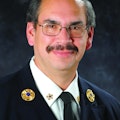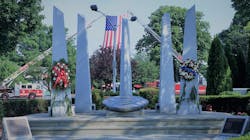Five Hackensack, NJ, firefighters died on July 1, 1988, while fighting a fire at an automobile dealership. The firefighters were in the bowstring-truss building when the roof suddenly collapsed. Three of the firefighters were killed in the middle of the service area where the garage doors are open after the truss roof and heavy ceiling collapsed. The two other firefighters were trapped in a rear storage room and could not be rescued.
We present a look at the changes within the Hackensack Fire Department in the 20 years since the tragedy. According to the fire department's website, "This fire, the worst tragedy to befall this department, caused sweeping changes in many aspects of firefighting not only in Hackensack, but the whole country. The memory of these nine brave men will live in our hearts forever."
The Hackensack Fire Department went fully paid in 1914 and the last new firehouse was built for Engine 2 in 1950. Current department strength is 99. Manpower has dropped from a high of 117 in 1978. Under a schedule instituted in 2001, there are four groups of 18 to 24 members working 24 hours on and 72 hours off. The department operates four engines, one ladder company and a rescue company under the command of a deputy chief each shift. There are three firehouses and the headquarters station. In 2007, the department responded to 8,796 calls. There were 2,896 fire responses and 5,720 EMS calls.
It was on July 1, 1988, that 10 Hackensack firefighters manning two engines, one ladder and one chief officer responded to a reported fire at the Hackensack Ford automobile dealership. During the operation, fire was discovered burning in the truss loft above the service area. The truck company vented the roof. Engine companies attempted to attack the fire through two hatches in the ceiling of the service area. An order to evacuate the building was given, but no units acknowledged the radio transmission. Three firefighters were trapped and killed when the heavy ceiling collapsed in the service area. Two firefighters were trapped in a rear storage room and radioed for help. They died before anyone could get to their position because of the truss collapse and heavy fire conditions.
Lessons Learned
Among the factors cited in the incident were a failure of the command structure, insufficient and ineffective radio communications, a lack of manpower, failure to recognize the truss roof/building construction and a lack of radios for the members on duty (a separate fireground frequency had been requested before the fire).
Changes that were made immediately after the fire included:
- Personal alert safety system (PASS) alarms were issued. These were donated by a local business.
- A building construction course was given to all members.
- A citywide survey and catalog of all truss-roof buildings was completed and put into an early computer-aided dispatch (CAD) system.
- The department created a formal standard operating procedure (SOP) and safety committee. Currently, there are 43 standard operating guidelines (SOGs).
- A safety officer position was established on an as-needed basis.
- A first-generation safety officer was sent to the National Fire Academy.
- A state law was enacted requiring all truss-roof buildings to be placarded, with the exception of private dwellings.
- The city hired civilian dispatchers to free up firefighters.
- Training and implementation of the Incident Command System (ICS) was instituted at all incidents.
- Members met the need for increased training by attending conferences and training courses.
- A fund-raising seminar taught by Chief Vincent Dunn was held.
- An officer was assigned to the rescue. Previously, rescue operated as a second section of the ladder company.
- Members were trained in hazardous materials and joined the Mid-Bergen mutual aid hazardous materials team.
Further Changes
In the mid-1990s, more changes were made as the department:
- Purchased four-inch hose for all engines.
- Purchased two engines and a ladder, all painted red.
- Issued first-generation bunker gear.
- Issued portable radios to all on-duty members.
- Implemented an accountability system. The tag system consists of three levels -- Level I, Level II (collected at working fires) and Level III (utilized at hazardous materials incidents and team searches).
- Printed daily riding assignments.
- Compiled an incoming mutual aid riding list.
- Purchased new 4.5 self-contained breathing apparatus (SCBA) masks and cylinders.
- Continued to update SOPs.
- Established a full-time training officer.
- Issued compliant work uniforms to all members.
- Issued personal SCBA facepieces.
- Implemented a citywide certified first responder program, with all members trained.
- Assigned a full-time safety/training officer, weekdays only.
- Implemented the rapid intervention team concept.
- Received a fully equipped rescue unit (Rescue 2), which was donated by Hackensack University Medical Center.
Since 2000
Changes made since 2000 included:
- Special operations teams were formed with select members trained in high-angle, trench and confined-space rescue. A truck was donated for special operations.
- A new rescue boat was purchased with a grant.
- The department purchased an ice-rescue sled and received cold-water rescue suits. Select members are trained in swift-water, cold-water and ice rescue.
- Large-diameter hose (LDH) water delivery was upgraded by replacing four-inch hose with five-inch hose.
- All 1¾-inch and 2½-inch hose was replaced, as were all nozzles, appliances and fittings. The department received lightweight 2½-inch high-rise hose and updated its standpipe equipment.
- Apparatus replacement continued.
- First-generation bunker gear was replaced. Most members were issued two full sets of bunker gear. A gear-cleaning contract and maintenance program were established.
- The department became involved in the New Jersey Urban Area Security Initiative (USAI) Task Force. Forty-plus members received extensive training in building collapse and urban search and rescue (USAR). A USAI rescue unit was placed with sophisticated rescue company gear for collapse rescue.
- Received a mask service unit from the Department of Homeland Security. The unit, which can be deployed anywhere in the county or state, carries 100 spare SCBA cylinders and can be utilized as a rehab sector. The department also received ice machines.
- A FIRE Act grant was received for rapid intervention team equipment for every engine company, including four gas meters, rotary saw, thermal imaging camera, extrication tool, chain saw, cordless drills and saws, search team ropes, portable radios, stretchers, lock-out/tag out kits, elevator drop keys, airbags, rebar cutters and radiological meters.
- International Association of Fire Fighters (IAFF) terrorism/weapons of mass destruction (WMD) training were conducted. Select members were trained as hazardous materials technicians. Chemical protective clothing (CPC) suits were placed on Engine 4 and Rescue 1, and members received training. Meters were placed in service for radiation, chlorine and other hazards.
- Four members joined New Jersey USAR Task Force 1 (NJTF 1).
- High-rise procedures were implemented. A high-rise task force was established in the Mid-Bergen Mutual Aid Association, including four engines, four ladders and the mask service unit.
- The department received a grant for personal bail-out equipment and all members were issued life-safety harnesses.
- All members were issued alphanumeric pagers for recall notifications and department messages made through an Internet connection in the dispatch office.
- A safety officer position was established. One safety officer per tour responds to all incidents and performs training officer duties. This person also is utilized as a covering officer when needed.
- The department received a 2007 SAFER (Staffing for Adequate Fire and Emergency Response) grant for 12 firefighter positions (not acted upon at this time).
- A FIRE Act grant of $331,000 was received for the dispatch center to be fully renovated. New base station equipment was purchased, and a new computer was purchased and installed into the city network.
- New portable radios were purchased for all front-line firefighters. Three frequencies are now available for use at incident scenes or for multiple incidents. All mutual aid departments have the frequencies for interoperability. A UHF frequency was obtained and assigned to special operations and EMS. Also received were a USAI base station radio for mobilization notifications and USAI portable radios for use in deployments. Nextel phones were acquired for all on-duty officers.
- An ongoing purchasing plan is underway to switch operations to a UHF frequency. At least two repeaters are required for total coverage within the city. The purchase of new mobile and portable radios is required.
- Computers were purchased for various apparatus for secure communications. A purchasing plan to equip all department apparatus is ongoing.
- Evacuation-tone and roll-call procedures were established with dispatch personnel monitoring the frequency. The department developed "man-down" capabilities on portable radios.
- Members received training in building construction, hazardous materials, and strategy and tactics. Select members have been sent to "New Jersey Weekends" at the National Fire Academy. Also, the department developed in-house pump operator and mask confidence courses, established training in ICS and the National Incident Management System (NIMS) for all members, (NIMS), and trained members in the National Fire Academy's "Calling a Mayday" course.
Recent Changes
Most recently, the department:
- Received a FIRE Act grant to purchase 55 airpacks with 30-minute cylinders and built-in PASS devices.
- Issued two portable radios to each engine company, three to the ladder company and two to the rescue company.
STEVE KALMAN is deputy chief of the Hackensack, NJ, Fire Department, currently serving as the tour commander of the Second Platoon. He is also a Level 2 New Jersey fire instructor working at the Bergen County Fire Academy.
HARVEY EISNER is editor-in-chief of Firehouse® Magazine.
IN MEMORIAM
Captain Richard Williams
Engine Company 304
Lieutenant Richard Reinhagen
Engine Company 302
Fireman Steven Ennis
Rescue Company 308
Fireman William Kresja
Engine Company 301
Fireman Leonard Radumski
Engine Company 302
About the Author

Harvey Eisner
Editor Emeritus
HARVEY EISNER was named Editor Emeritus of Firehouse® after serving 15 years as Firehouse's Editor-in-Chief. He joined the Tenafly, NJ, Fire Department in 1975 and served as chief of department for 12 years. He was a firefighter in the Stillwater, OK, Fire Department for three years while attending Oklahoma State University. Eisner was an honorary assistant chief of the FDNY and program director for the Firehouse Expo, Firehouse World and Firehouse Central conferences. He covered many major fires and disasters and interviewed numerous fire service leaders for Firehouse®
